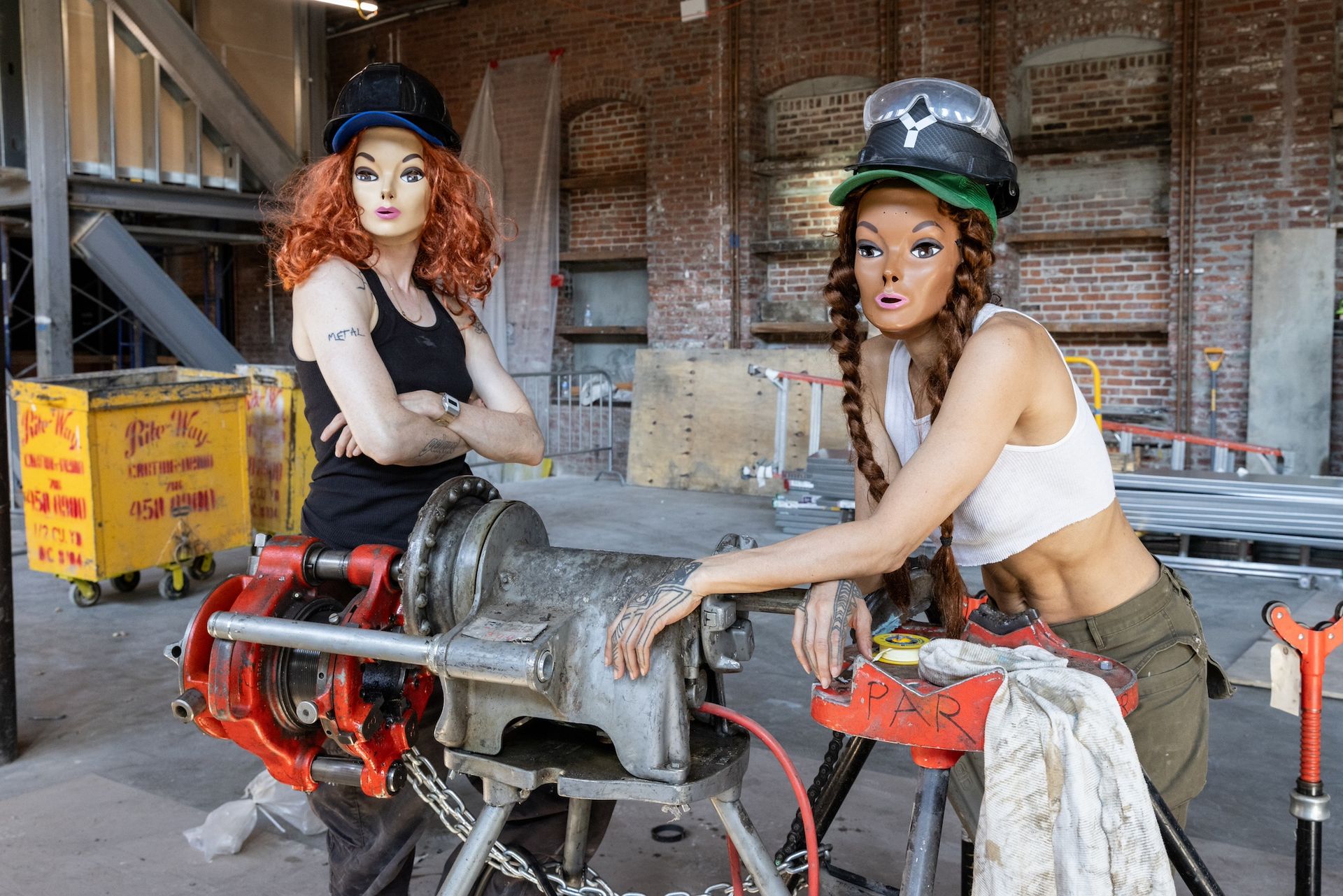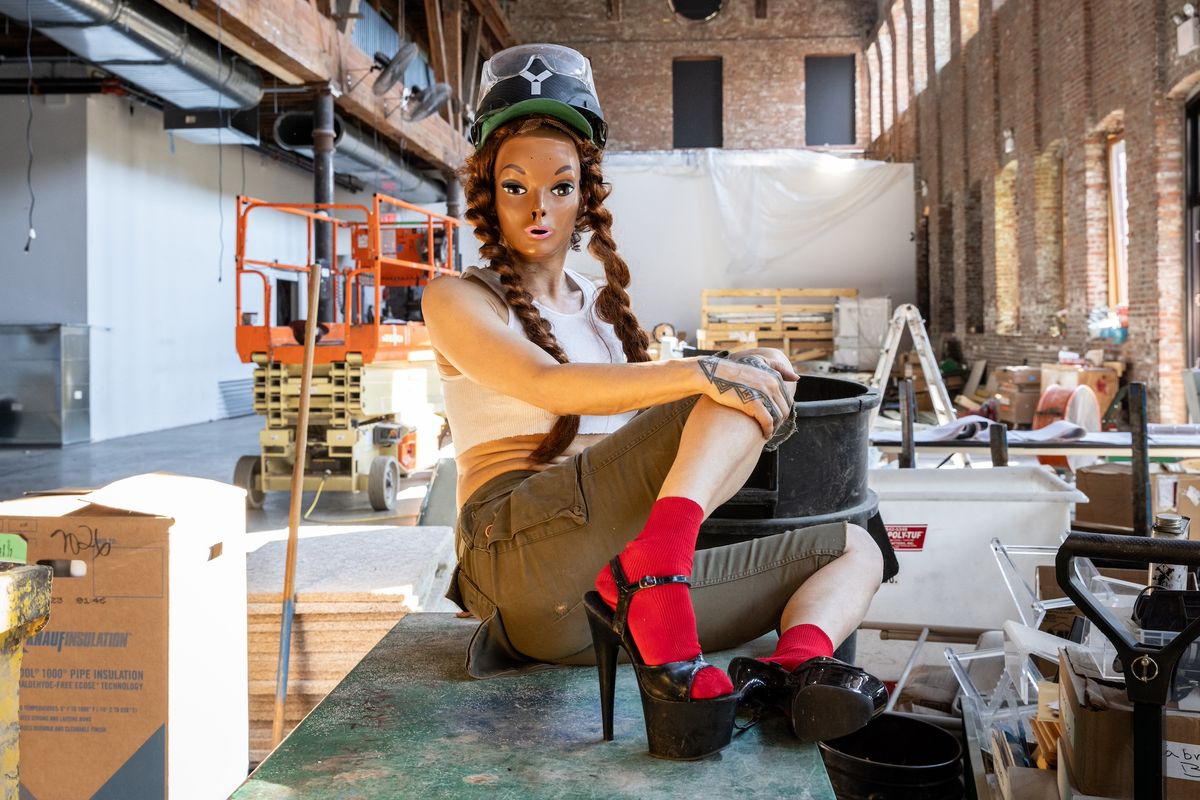Narcissister is a master of disguise. The pseudonymous New York artist never appears without her distinctive mask, inspired by a wig display from the 1960s, but she is also perennially donning and shedding bespoke costumes that upend familiar conventions of gender, age, race, class and sexuality. Sometimes she even upends gravity: one of her many sleight-of-hand performances involves doing a handstand in a costume in which her arms are covered by trouser legs or a skirt, her legs contort through the arms of a shirt and a mannequin head placed between her legs completes the upside-down illusion. (Unsurprisingly, this was a hit when she appeared on America’s Got Talent in 2011.)
For her new project at Pioneer Works in Brooklyn, Voyage Into Infinity (14-15 September), the artist is working with an ensemble of collaborators (all of whom will wear the trademark Narcissister mask) on a theatrical tableau and performance, which will be accompanied by a live score by Holland Andrews. Titled after a song by the pioneering punk band Bad Brains, the piece will have a distinctly punk aesthetic, unfolding on and around a sculptural set made almost entirely from found and salvaged materials. Voyage Into Infinity will also reinterpret and reframe Peter Fischli and David Weiss’s canonical film The Way Things Go (1987), which follows the chain reactions of a low-tech Rube Goldberg contraption.
Ahead of the piece’s debut, Narcissister discussed the project’s genesis and execution with The Art Newspaper.
The Art Newspaper: Why did you title this piece after the Bad Brains song? How do you see the project relating to that song?
Narcissister: The song came to me unpredictably, as happens often with my work. I have a bunch of music loaded onto my laptop, and I was working in my studio with the music on shuffle and that song came up. I was reminded of how epic the intro and the outro are. It struck me as something that would be a really strong element for the work, and I was inspired to incorporate the song. When I was thinking of a title for the piece, the title of that song started to become more and more an anchor for the work.

Narcissister and a collaborator working on her new project at Pioneer Works, Voyage Into Infinity (2024) Photo by Walter Wlodarczyk, courtesy Pioneer Works
A couple more signifiers have emerged in the process of making the work. One is that, in preliminary research about this song, I learned that the singer of Bad Brains has made some homophobic statements, and as I have been playing the song and incorporating it into the piece, people have shared different stories that backed that up. I am interested in that, because we also have a statue in the piece that I found in a garden centre on Long Island because I liked the pose. When I started to research the statue, I discovered that it’s a replica of a statue that Hitler owned and kept as some kind of symbol of the beauty and the potential of the Aryan race. There are also pyrotechnics in the show, and we're incorporating something called the Catherine wheel. Historically, those wheels were used to torture women. I’ve just picked things that I’ve liked, whether it's the Bad Brains song, the statue or the visual of a pyrotechnic Catherine wheel, and then these other layers of meaning have emerged. We are reframing these symbols or signifiers through their inclusion in the work.
As far as the title goes, the piece is about many things and incorporates many of the themes that Narcissister has done for a long time, around issues of race, identity, femininity, feminism, sexual expression and free, self-loving eroticism. Something that my project has started to incorporate are questions around ageing for women—loving, accepting and honouring that passage. In a subtle way, and in the mix with all the other issues I just mentioned, Voyage Into Infinity seems an apt title for a piece that includes an exploration of ageing.
You are also referencing Fischli & Weiss’s The Way Things Go. What attracted you to that video in particular?
I encountered that work as a younger artist, still dreaming of what my singular vision might be. I remember seeing that piece and being struck by it—that that could be considered art—and fascinated and charmed by it, and just excited by the virtuosity of it. It stayed with me and expanded, in my mind, what could be considered art or framed as a work of art.
Since I was a child, I have been very curious about the way things work. I would climb on top of the washer and dryer in our house to reach my dad’s tool shelves and just loved poking around and seeing what was there, pulling tools out and building things. And my costumes have emerged from these interests. I learned to sew at a very young age, and my costumes are lo-fi feats of engineering, where I've had to learn how to make one thing segue very quickly into another thing and then another thing. It all seems like a similar practice to a Rube Goldberg machine, or to what was created in The Way Things Go.

Narcissister and a collaborator working on her new project at Pioneer Works, Voyage Into Infinity (2024) Photo by Walter Wlodarczyk, courtesy Pioneer Works
More recently, I have been reframing the theatrical props that I’ve been making for a long time for my solo performances as participatory sculptures. Creating a monumental Rube Goldberg machine—installation, participatory sculpture, spectacle and performance stayed with me as a really juicy idea. So when this opportunity to present something at Pioneer Works came up, I just knew this would be such a wonderful space to present it.
Your performances always involve elements of sleight-of-hand, magic and spectacle, from the mask and elaborate costumes to doubled figures and more. How do you think about the veracity of the illusion? Is it important for viewers to be surprised or deceived in some way, or do you want them to also be aware of the artifice of what they are seeing?
Almost all the works I’ve made incorporate some aspect of lo-fi illusion or a DIY magic trick. That’s something that’s always been fascinating to me. It looks improbable, but somebody has figured out how to fool us, to create this suspension of disbelief, and there’s a virtuosity and incredible skill in that. It’s this way of thinking that I have been excited about since I was very young, and have done my best to incorporate in my work: believing that we can shift people’s perceptions of something. We think we know what it is, but it's really not at all what we thought.
That destabilising experience of the reveal—I'm excited about the skill required to pull these things off and the virtuosity of it. I somehow have the kind of brain that can think about how to create these magic effects, or these illusions. One of my favourite things to watch is that TV show Magic's Biggest Secrets Finally Revealed. Even when they show you how they did it, it’s still incredible.
And when you layer onto this sleight of hand and this destabilising creation of a world that isn't really the world that you think it is, the other issues in my work—around womanhood, race, ageing or just general questions of identity—it becomes very rich for me and very true to what our experiences are. I’m making it more literal by creating this feeling of illusion or magic or instability through the visuals. And doing it in a way that’s a little bit rough and shows the seams, and the work behind it adds even more to that complexity.
You are working with a group of fellow performers for this piece. How do you approach that process? Do you have a script for them to follow, or is the performance developed collaboratively?
I’ve incorporated extra Narcissisters in my work almost since the beginning, so the performers who are in this piece with me have been in other works of mine, some of them for quite a long time. I’ve been creating the work with the builders here at Pioneer Works. We've been setting a lot of the moments that incorporate performers on me. And then relatively recently, the performers joined, and I've been teaching them how to interact with the machine. And now that the machine is basically finished, now is the time when the performers are here more intensively and we’re discovering not only the things that I found interacting with the machine, but what are things that the other performers can find in interacting with it, what pictures can we create as a group, what’s our relationship with the machine as a group? That process is unfolding now. There is a script—I think most Rube Goldberg machines have a script, or the list of steps. And then there’s a score that’s been created, which is what the performer involvement is about.

Narcissister and a collaborator working on her new project at Pioneer Works, Voyage Into Infinity (2024) Photo by Walter Wlodarczyk, courtesy Pioneer Works
What kind of spaces are you drawing inspiration from for the environment you are creating? Are you thinking of it more as a set, an installation or a sculpture?
It’s an installation, a chain-reaction machine and also the set piece for this performance and for the performers to interact with. There are some little nods to objects and moments from The Way Things Go. There are pieces taken from large-scale sculptures that are in the art canon, especially outdoor and kinetic sculptures. And there are some more direct, art-historical references in terms of how the statue that I mentioned is placed in the space. I’ve also taken some inspiration from the circus. And then there are some visual themes, ideas, styles and vibes that are part of my world as Narcissister.
This piece has so many elements—the sculptural installation, the performance, the video that will be shot of the performance. Do you consider one of these elements the primary part of the piece, or are they all equally important?
The video is exciting for me because The Way Things Go, the main point of inspiration for this work, is known exclusively as a video. So I'm excited about having a video that can have a life of its own and be circulated and presented in art spaces and perhaps film festivals. The video is going to be direct documentation; I'm not interested in incorporating any poetry, so to speak, in the style of the video. I would love to perform this work again in other places. I don't know if it will be with these same exact elements, but obviously, this video will capture this iteration.
Everything in the project has been found—either on the street, at Materials for the Arts or things that I have in my collection of objects. There are very few things that have been purchased for this piece, and for me that's important. I have done my best to remain faithful to that, with one or two exceptions, like the statue I needed to purchase from the garden centre on Long Island. So if or when the work is presented again in other places, I would be excited to find new things sourced from wherever that location is.
- Narcissister: Voyage Into Infinity, 14-15 September, Pioneer Works, Brooklyn


